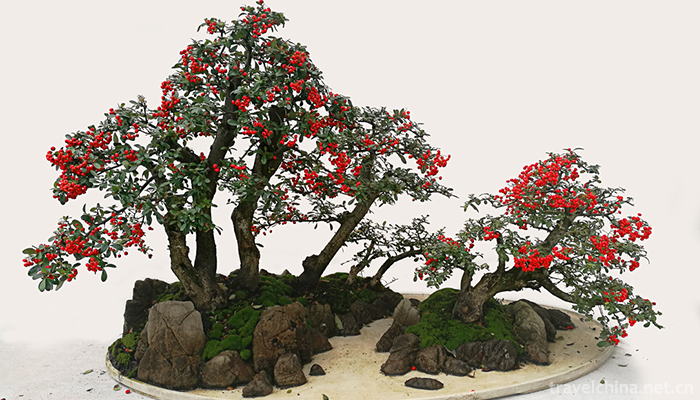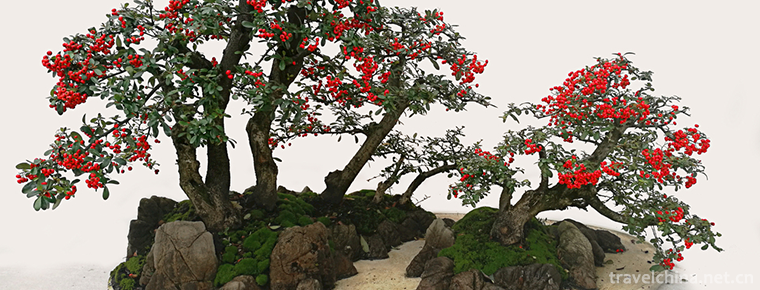The technical skill of penjing
The technical skill of penjing
Bonsai art refers to the Soviet bonsai art, which originated in the Tang Dynasty, flourished in the Ming Dynasty, matured in the Qing Dynasty, and developed in modern times. Since the 1980s, Suzhou Bonsai has won many awards in exhibitions at home and abroad.
Bonsai is one of the traditional Chinese arts with a long history. Bonsai production often takes several years or decades to create. It is undoubtedly the desire of bonsai enthusiasts and producers to create a good-looking wound in a relatively short time.
In 2011, it was selected as the third batch of national intangible cultural heritage list.
Historical Origin
Bonsai art refers to the Soviet bonsai art, which originated in the Tang Dynasty, flourished in the Ming Dynasty, matured in the Qing Dynasty, and developed in modern times. Since the 1980s, Suzhou Bonsai has won many awards in exhibitions at home and abroad.
Bonsai is a combination of planting plants in a vessel, decorating mountains and rocks, etc., to show a kind of artistic conception of nature, and to see the changes of the four seasons.
Skill Tips
Branches are straight and curved.
Sparse places can walk horses, close places can not be ventilated.
One branch sees twists and turns, two branches are long or short, three branches are scattered, many branches are exposed and hidden.
The straight position should be hidden but not exposed, and the straight position should be exposed and not hidden.
Plum-blossom bonsai would rather bend than straighten.
Bonsai is a silent poem, three-dimensional painting and living sculpture.
On the day of Jingcheng, the achievements will last for ten years! ___________
If you are not afraid of cutting wrong branches, you are afraid of standing in wrong places.
Store up skills and cut off dryness. Zhangshan, Chishu, inch horse, divide people. There are no trees in the distant mountains.
Creation is a wonderful painter, and the terrain is very close to the sky.
Jiaolong has 30,000 hectares and 12 peaks in rain and cloud.
Seats make people vulgar, leisure to act as a fresh breeze.
Drunken Dream in the Leaf of the River and Lake
Go strong and leave weak; go coarse and leave thin.
The trial should be accurate and the verdict should be ruthless.
Rugao bonsai, looking left and right at two and a half bends, clouds, rain feet, beauty waist.
If you don't pour it, it will penetrate.
Dry and wet, thin fertilizer and diligent application;
Scenic trees have no roots, like cutting wooden pavilions at the top, potted landscape feet.
Spring wiping ectopic buds,
Cut strong and weak branches in summer.
In autumn, topdressing should be done.
Cut the branches in winter.
Note: This is a part of Potted Landscape Skills Tips. See Resources for more information
Inheritance Significance
After thousands of years of inheritance, Chinese bonsai art has experienced many natural disasters and social turbulence, and has finally become an important part of Chinese and Eastern culture. Further implement the working principle of "protection first, rescue first, rational utilization, inheritance and development", conscientiously do a good job in the protection and management of intangible cultural heritage, and make new contributions to the promotion of Chinese culture and the great development and prosperity of socialist culture.


-
2.South Lake
Nanhu, formerly known as Luweichi Lake, also known as Machang Lake and Luanhu Lake , is located in Nanhu District, Jiaxing City, Zhejiang Province
Time 2018-12-07 -
3.Shanghai Zoo
Shanghai Zoo is located at 2381 Hongqiao Road, Changning District, Shanghai, which is close to Shanghai Hongqiao International Airport. Founded in 1954, originally known as the West Suburb Park. Shang
Time 2018-12-19 -
4.Huhu Water Eco Scenic Spot
Located in the southwestern edge of Pingshan County, Hebei Province, the old revolutionary area, the Biaoshui Eco-Scenic Spot has a tourist area of 11.5 square kilometers, an altitude of 800-1100 mete
Time 2019-01-12 -
5.Kaiping Diaolou and Villages
In Kaiping city, there are many blockhouses, towns and countryside. There are more than a dozen villages and less than two or three villages. From Shuikou to Lily
Time 2019-01-29 -
6.Western Xia imperial tombs
The Mausoleum of the Xixia Dynasty, also known as the mausoleum of the Xixia Emperor and the mausoleum of the Xixia Emperor, is the mausoleum of the successive emperors and the Royal Mausoleum of the
Time 2019-02-25 -
7.Tibetan costume
Tibetan costumes Tibetan men's clothes are divided into three categories: labor dress, superfluous dress and warrior dress. Women's clothes change greatly in festivals, major events in life and etique
Time 2019-04-05 -
8.Foshan Wood Engraving New Year Pictures
Foshan woodcut New Year's picture is a famous folk New Year's picture in South China and a wonderful flower of Lingnan traditional folk culture. It is as famous as the New Year
Time 2019-04-29 -
9.The Story of Guangchan Marquis
The story of Guangchan Marquis refers to a local folklore widely circulated in Yangcheng County, Jincheng City. Guangchan Marquis refers to an ordinary folk veterinarian in the Northern Song Dynasty
Time 2019-05-01 -
10.She Nationality Medicine
She medicine is mainly distributed in Jingning She Autonomous County of Zhejiang Province and in some mountainous areas of Fujian and Jiangxi provinces. She nationality has no written language and is
Time 2019-06-14 -
11.Tu Costume
Women usually wear embroidered small collar and long slant-skinned shirt. The sleeves are made of red, yellow, orange, blue, white, green and black seven-color cloth rings. They are bright and beautif
Time 2019-06-23 -
12.History of Leshan
Leshan used to be the capital of Kaiming tribe in ancient Shu state. In 309 B.C., King Wu of Qin sent troops to the south to wipe out the rule of the Kaiming family. The state of Qin established Nan'an County in Shizhong District of Leshan City
Time 2020-12-17